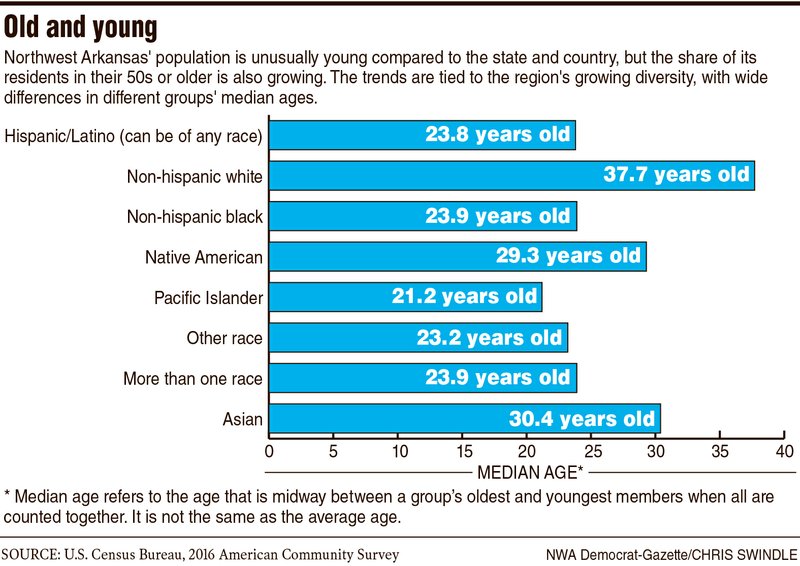FAYETTEVILLE -- Northwest Arkansas skews younger than the rest of the state and the country, but its population is also growing at the other end of the age spectrum.
Census counts and surveys since 2000 show the Fayetteville-Springdale-Rogers metropolitan statistical area is spreading in terms of age distribution. About 1 in 4 residents fall under the age of 18, but those above age 55 are catching up with them in population share. The percentage in between is shrinking.
The region in 2016, the latest year with available estimates, was home to 120,000 residents 55 or older. That's up 38 percent in the previous decade, 12 percentage points faster than the region's overall population grew in that time.
Experts and advocates say longer lives, plenty of jobs for older people or their children, and a warmer climate contribute to the area's "silver tsunami," as Graham Cobb, Greater Bentonville Chamber of Commerce CEO, put it last month.
Northwest Arkansas' older residents bring their own health and housing needs, and the region should prepare accordingly, several experts and residents said.
"Our communities have stepped up and helped," said Jerry Mitchell, who directs the local Area Agency on Aging and has worked to improve senior citizens' access to healthy food and social activities. "But, all told, we should be doing more."
Beth Sylvester's family in Fayetteville is living out the region's demographic changes: Her 23-year-old son is about to graduate from college. Her parents have reached their 80s and moved in with her and her husband a few years ago. Sylvester said they lived in New Mexico, Colorado and elsewhere but always loved Fayetteville and wanted to be close to family members.
They extended the house to accommodate her parents, essentially adding a connected cottage. Sylvester's parents wanted to downsize and could help care for her husband, Mike, who uses a wheelchair after several strokes and lifelong diabetes.
But her parents are aging, too, Sylvester said, and need their own assistance. To help everyone, the entire one-story house has wider doorways, walk-in showers and other easy-to-use features. The modifications make the house safer and accessible to anyone with physical disabilities as Sylvester gets on in years herself, she added.
"It gives me the peace of mind to know I can stay here as long as I need to stay," said Sylvester, who works from home as a project manager for Sallie Mae.
A "lifelong housing" working group of volunteers and local officials wants to make it normal and common for homes to be built with the wider doors and other features for aging in place. Beth Barham, a member who also works with the League of Women Voters of Washington County, said one of its goals is a local certification program that can gauge how aging-friendly housing is.
Injuries over a lifetime and the strain of aging can force older people out of homes with stairs and bathtubs, said Barham, a baby boomer. Nursing homes and hospitals can only try to keep up.
"And frankly, there's just no way we could afford to build enough" of those facilities, she said. "That means the housing stock needs to be shifting."
The idea is catching on slowly among local contractors, said Tim Janacek, president of Janacek Remodeling in Rogers and a member of the Northwest Arkansas Home Builders Association's board. Janacek is a certified aging-in-place specialist through the National Association of Home Builders and makes it a point to include aging-friendly features in all of his projects.
"It's just an interest that needs to be cultivated," Janacek said. He and Barham pointed to cost as a major barrier to this type of renovation. Sylvester's changes, for instance, cost tens of thousands of dollars, out of reach for many senior citizens on fixed incomes and lower-income families.
Medicaid helps cover several thousand dollars of changes for enrollees who need the modifications to be able to stay in their home, Barham said. Sylvester said she got a tax break for disability accessibility. But Barham said building with aging in mind in the first place would prevent the need for the renovations.
Health care providers, meanwhile, are adapting to the population's spreading age distribution by adding locations and services.
Washington Regional Medical Center in Fayetteville is expanding care for strokes and other ailments through an ongoing, $43 million expansion. Mercy Northwest Arkansas has begun a minimally invasive heart valve-replacement procedure for patients who are often in their 80s or older, and Washington Regional plans to join it this summer. Mercy and Northwest Health have added new joint replacement procedures in the past several months as well.
Mercy Hospital president Eric Pianalto in a February interview described the system's approach as aiming in two directions, meeting the needs of the old and the young. The number of people needing advanced procedures is high enough the hospital can offer them safely and at competitive costs, he said.
Mitchell, with the aging agency, sees a persistent need for food among senior citizens as well. About one in five people age 60 and older in Arkansas skipped meals, worried about running out of food before getting money to buy more, or experienced some other sign of food insecurity in 2015, according to the latest annual report from the National Foundation to End Senior Hunger.
That puts Arkansas at the fifth highest senior hunger level in the country, down from No. 1 in 2014.
Mitchell credited the improvement to donations from companies like Tyson Foods and work by food banks to reach older clients. His agency provides Meals on Wheels and home care and runs senior citizen centers for more than 10,000 clients in nine Northwest Arkansas counties using state and federal aid.
Metro on 03/12/2018
